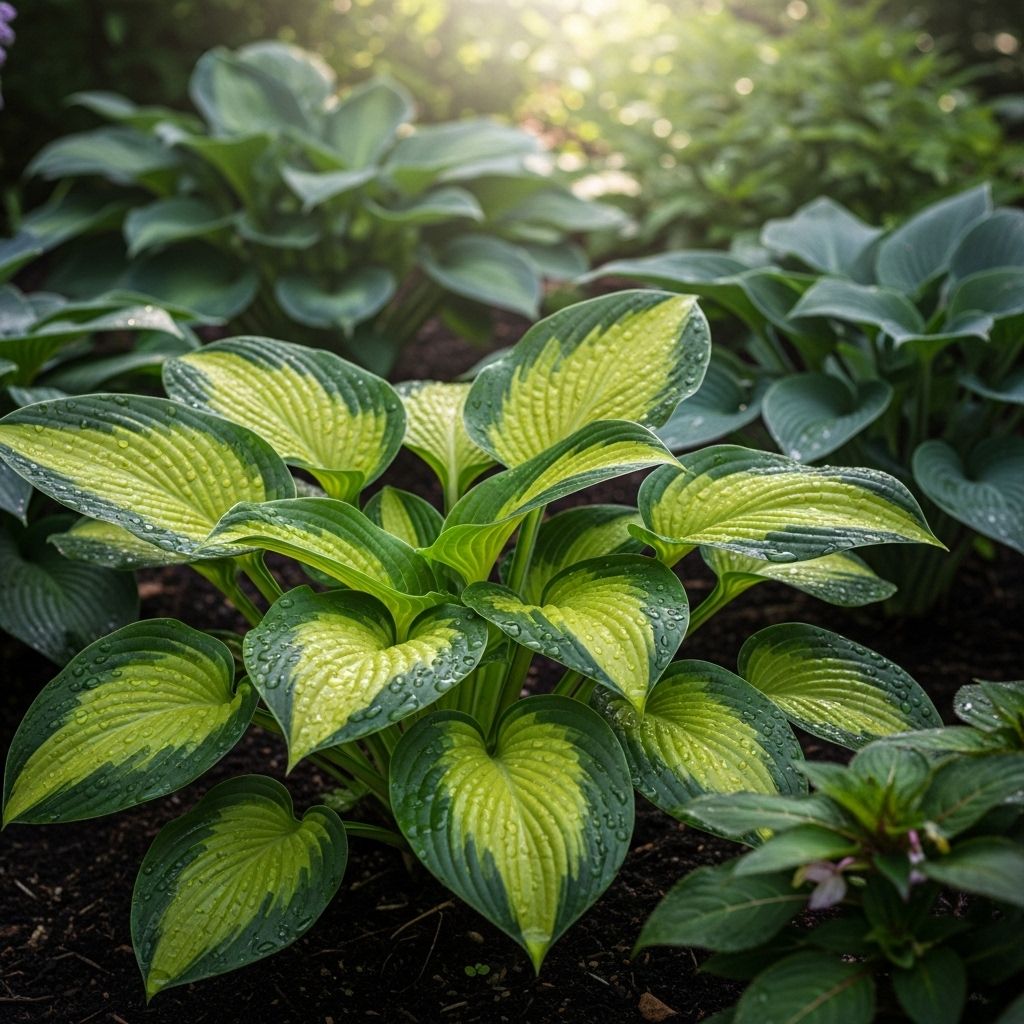Hostas: Sun or Shade? Ultimate Guide to Planting, Light Needs, and Care
Balancing sun exposure and shade brings out striking leaf colors and healthy growth.

Can Hostas Take Full Sun? Or Do They Need Partial to Full Shade?
Hostas have long been celebrated as the essential plant for shade gardens, famed for their broad, spectacular foliage and versatile use as groundcovers and accent plants. But gardeners often ask: Do hostas only survive in partial to full shade? Or can some varieties actually tolerate, or even thrive in, sunlit spots? This guide explores the nuances of hosta sunlight requirements, helping you position each plant variety for maximum health and ornamental appeal in your landscape.
Understanding Sun and Shade Requirements for Hostas
While most hostas are regarded as shade-loving perennials, there is significant variability across the many cultivars:
- Partial shade (dappled sun, morning light) is ideal for many varieties.
- Full shade suits blue-leafed and some older types best.
- Some gold, chartreuse, and variegated varieties can thrive with substantial morning and even midday sun—given enough water and protection from the hottest rays.
This means that selecting the right spot involves understanding both your local sun patterns and the specific hosta varieties you plan to grow.
Shade-Loving Hosta Varieties
Classic hostas, especially those with rich blue-green or deep green foliage, prefer shade and minimal direct sunlight. These types excel in woodland borders, beneath large shade trees, and the north or east sides of buildings, where direct sun rarely penetrates.
- Blue-leafed hostas favor full to deep shade. Direct sun will burn their leaves and melt the waxy coating that gives them their characteristic color.
- Deep green varieties also show their best color and vigor in mostly shaded conditions.
- Shade-lovers are usually fine with a touch of early morning sun exposure, but prolonged midday or afternoon sunlight can scorch the foliage.
Tips for Planting Hostas in Shade
- Select areas protected from hot, afternoon sunlight.
- If planting beneath trees, choose those with deep root systems (like oaks), rather than shallow-rooted species (like maples), to reduce competition for nutrients and water.
- Provide rich, moist, well-drained soil with a generous mulch layer to preserve moisture.
Hosta Varieties That Tolerate Sun
A surprising number of modern hosta cultivars tolerate (and sometimes require) more sun to perform at their best. Varieties with gold, chartreuse, or variegated foliage often need more light to achieve vibrant color and vigorous growth.
- Yellow and chartreuse hostas (e.g., ‘Sum and Substance’, ‘Dancing Queen’, ‘Guacamole’) can handle locations with 4–6 hours of sun, ideally in the morning or as filtered sunlight.
- Some variegated types also benefit from brighter spots, but beware of scorching in intense sun areas—especially during summer heatwaves.
When growing hostas in sunny conditions:
- Ensure regular, deep watering, as hostas lose moisture quickly in sun-exposed sites.
- Monitor for stress signs: browned or crispy leaf edges indicate sunburn. Lightening and fading colors can also be a sign to provide more shade.
Hostas for Sunny Spots (Partial to Full Sun Tolerant)
| Variety | Sun Tolerance | Leaf Color |
|---|---|---|
| Sum and Substance | 4–6 hours, morning/filtered | Chartreuse, gold |
| Guacamole | Partial sun | Apple green with gold center |
| Dancing Queen | Morning sun, dappled light | Bright yellow |
| Sun Power | Bright filtered sun | Yellow/green |
| Fragrant Bouquet | Partial sun | Green with creamy margins |
Recognizing Sun Stress in Hostas
Hostas “communicate” their discomfort through visible leaf changes. Look for:
- Burnt, crispy edges or bleached-out patches: too much direct sunlight.
- Faded colors, poor growth, or stunted leaves: either too much sun or, conversely, not enough light for that particular variety.
- Slow emergence or poor return after winter: excessive shade can reduce stored energy for dormancy and regrowth.
A quick move or added protection (shade cloth, repositioning) can save your hosta if you notice these early.
Best Planting Locations for Hostas: Matching Plant to Site
The key to a thriving hosta display is matching each cultivar to its optimal amount of sunlight. Use the following strategies as a guide:
- Morning sun, afternoon shade: Ideal for sun-tolerant yellow or gold hostas.
- Dappled sunlight: Great for variegated and green-leaf varieties.
- Full or deep shade: Choose classic blue, deep green, or shade-selected types.
Hostas will also grow happily in large containers, offering flexibility in relocating them to strike the perfect light balance throughout the year.
Watering and Soil Essentials for Sun and Shade
Regardless of sunlight, adequate moisture is vital for all hostas:
- Newly planted hostas require frequent watering until established.
- Hostas in sun need more water than those in shade—sometimes daily during hot spells.
- Once well established, hostas are fairly drought-tolerant, especially in partial shade.
- Mulching helps retain soil moisture and keeps roots cool.
The best soil for hostas is rich, organic, and well-drained. Amend garden soil with compost or leaf mold and ensure areas beneath trees aren’t bone-dry or overly compacted.
Large Hostas in the Shade Garden
Large hosta varieties (over 19 inches tall) create dramatic backdrops and striking focal points in shade beds. Use their substantial foliage to anchor garden designs, soften the edges of shaded structures, or screen unsightly views.
- Planting large hostas toward the rear, with smaller kinds in front, adds layers of texture and color interest.
- Mix large and medium hostas to achieve depth and variety in shade plantings.
Hosta Care Tips for Every Garden
- Divide mature clumps every 4–5 years, ideally in spring or early fall, to prevent crowding and maintain vigor.
- Fertilize early in the season with a balanced, slow-release fertilizer to encourage lush growth.
- Mulch annually to keep roots moist and prevent weeds.
- Protect from slugs and snails—use organic baits or barriers if necessary.
Great Companion Plants for Hostas
Hostas combine beautifully with a range of other shade-perennials, enhancing garden diversity and resilience. Consider grouping them with:
- Coral bells (Heuchera): Many color choices; prefers similar light and soil conditions.
- Japanese painted ferns and Autumn ferns: Textural contrast for hosta leaves.
- Brunnera (e.g. ‘Jack Frost’) and primroses for layered foliage effects.
- Impatiens, dead nettle (Lamium), and bleeding heart (Dicentra): Brightens up shade containers and beds.
- Shade azaleas and hellebores: For early-season color and structure.
Frequently Asked Questions About Hostas, Sunlight, and Care
Can any hostas be grown in full sun?
Most hostas will struggle in all-day, intense sunlight, developing leaf damage or stunted growth. Some gold, chartreuse, and sun-tolerant varieties can grow in partial sun (4–6 hours, especially morning), but regular watering and monitoring for stress are crucial.
What happens if my hosta gets too much sun?
Look for signs such as browning, crispy, or bleached leaf edges. The plant may also look faded and wilted. Move to a shadier spot, or use shade cloth or companion plants to provide relief.
Can hostas survive in deep shade?
Classic blue and green hostas will thrive in deep shade, but gold or variegated types may lose vibrancy. If your hostas become leggy or pale, try increasing the available light.
What is the best soil for hostas?
Hostas prefer rich, loose, well-drained soil high in organic matter. Amending with compost, leaf mold, or aged manure is highly beneficial. Soil should remain consistently moist but not soggy.
How often do hostas need watering?
Newly planted hostas should be kept consistently moist. Shaded hostas may only need supplemental water during dry spells, while hostas in sunnier spots require more frequent and deeper watering, especially in heat.
Hosta Care at a Glance
- Light: Match variety to site for best results. Observe plant behavior and leaf color.
- Soil: Moist, rich, and well-drained soil with plenty of compost.
- Watering: Deep and regular during dry or sunny conditions.
- Mulch: Mulch annually to conserve water and regulate temperature.
- Dividing: Split mature clumps every several years to sustain vigor.
- Pest Control: Use natural methods to reduce slug/snail damage.
Summary: Matching the Right Hosta to the Right Spot
Gardening with hostas is all about placing the right type in the right spot. Whether you have full shade beneath mature trees, dappled morning light, or a partly sunny border, there is a hosta cultivar that will meet your needs and thrive with minimal fuss. Observe your light patterns, explore new varieties, and combine hostas with other shade-loving plants for a dynamic, resilient garden—no matter how much sun or shade your landscape can offer.
References
Read full bio of Shinta












